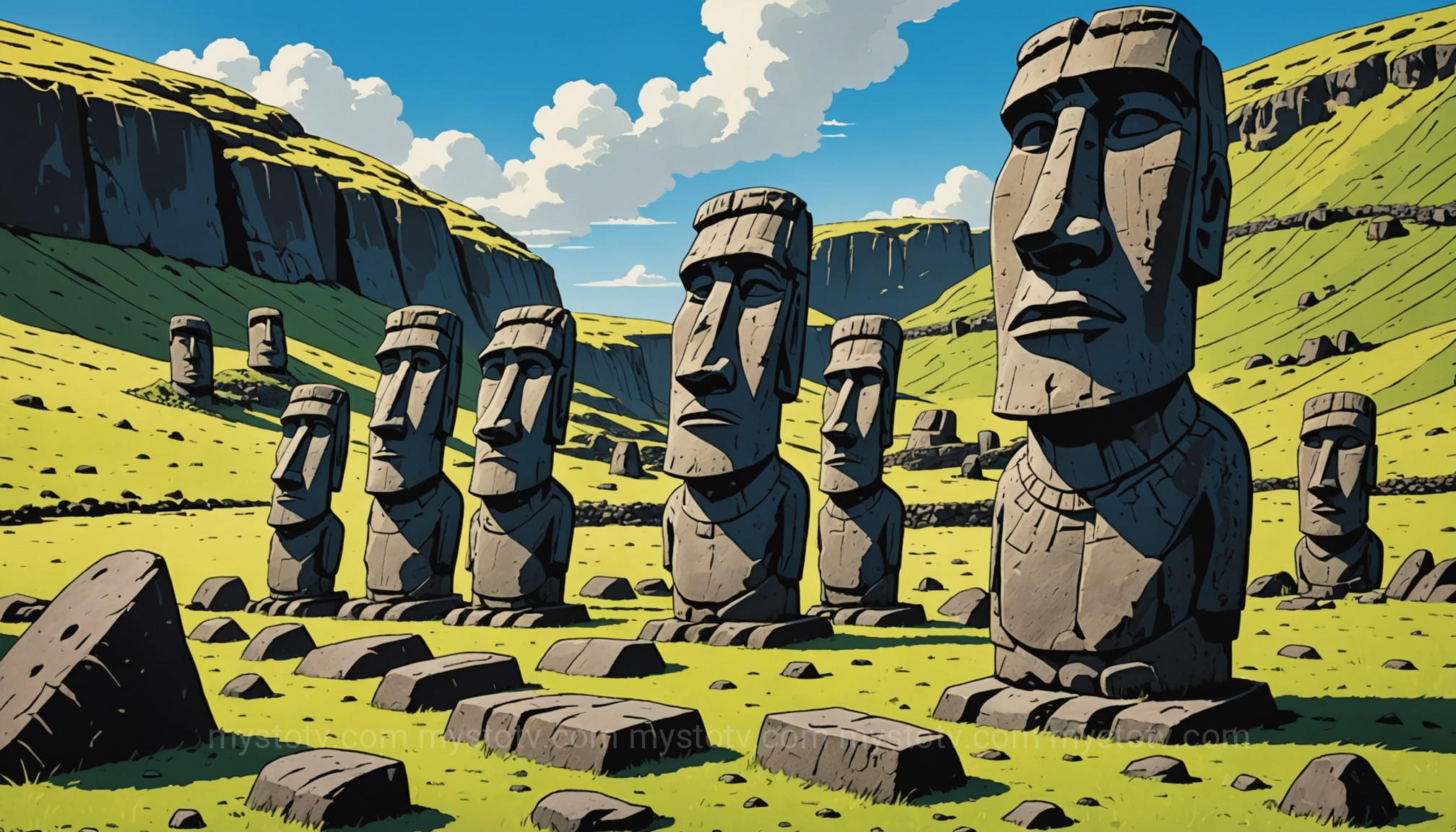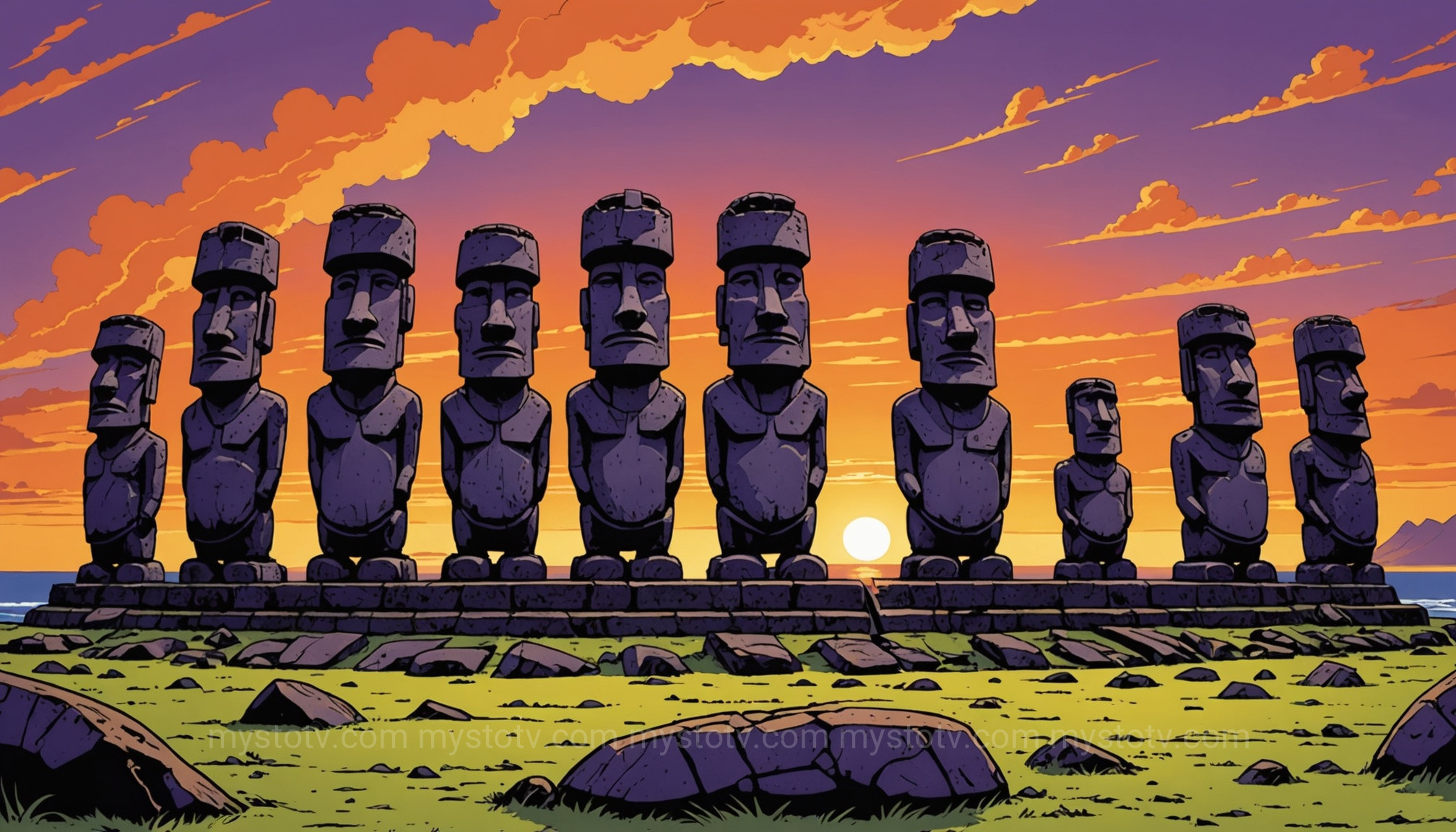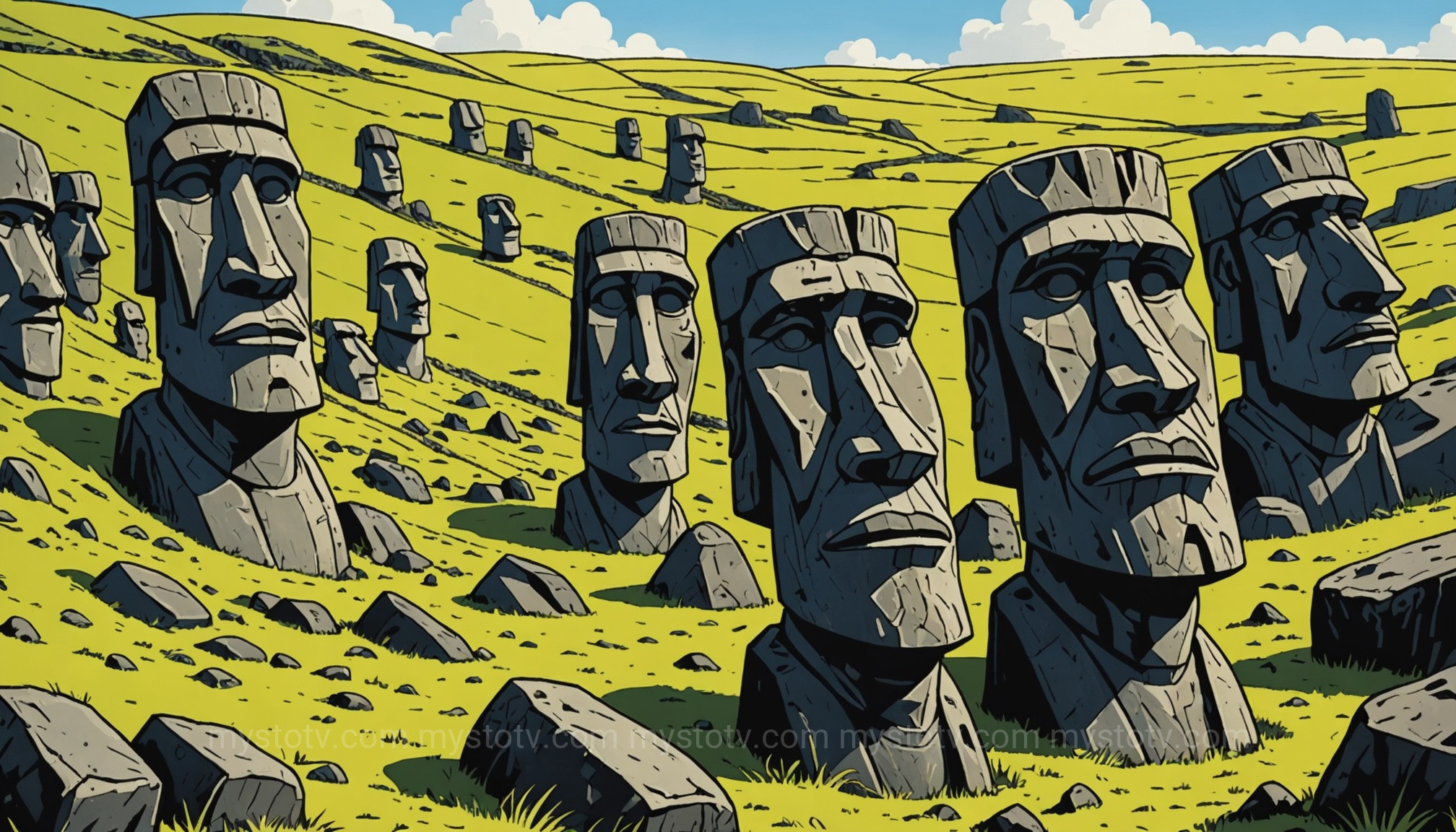I’ll never forget the first time I saw a documentary about Rapa Nui. The camera panned across a coastline dotted with colossal, brooding faces, staring inland with an air of silent authority. Like most people, I was captivated by the sheer mystery of the easter island heads. For years, I pictured them as just that: giant, disembodied heads resting on the soil. It was a simple, powerful image. The reality, as I later learned through more obsessive research, is far more complex and staggering. The moment I saw the first photograph of an excavated statue, revealing a full torso covered in intricate carvings, the entire narrative shifted. The mystery didn't shrink; it deepened, transforming from a simple question of "why?" to a sprawling epic of engineering, belief, and survival.
Contents
- 1 The Astonishing Discovery: What Lies Beneath the Easter Island Heads?
- 2 Unraveling the Purpose: Why Were the Easter Island Heads Built?
- 3 The Engineering Marvel: How Were the Easter Island Heads Carved and Moved?
- 4 The Story of Collapse: What Happened to the Rapa Nui People and their Easter Island Heads?
- 5 References
- 6 Conclusion: The Enduring Legacy of the Easter Island Heads
The Astonishing Discovery: What Lies Beneath the Easter Island Heads?

For decades, the most pervasive image of the easter island heads, or moai, was of the stoic figures at the Rano Raraku quarry, buried up to their shoulders in sediment. This led to the worldwide belief that they were simply heads. However, this was never a secret to the native Rapa Nui people or to the archaeologists who have studied the island for over a century. The "discovery" that went viral in the 2010s was simply the wider world catching up with decades of patient scientific work.
The Easter Island Statue Project (EISP) Excavations
The team most responsible for bringing this truth to light is the Easter Island Statue Project (EISP), co-directed by archaeologist Jo Anne Van Tilburg. Since 1982, the EISP has been meticulously cataloging and studying every single moai on the island. Their excavations, particularly at the Rano Raraku quarry where most moai were carved, were focused on conservation and study. By carefully removing centuries of accumulated soil and rock, they unearthed the statues' torsos, revealing details hidden for generations.
What they found was astonishing. The buried bodies were not plain; the backs of the moai were often covered in intricate petroglyphs. These designs, protected from weathering by the soil, included crescents representing canoes (vaka) and other symbols whose meanings are still debated by scholars. This finding was monumental because it proved the statues were not just generic representations; each one was likely a specific, individualized monument.
Analysis: More Than Just Statues
The confirmation that the easter island heads have bodies fundamentally changes our understanding of them. They are not abstract sculptures but complete anthropomorphic figures, representing whole beings. The presence of detailed carvings on their backs, which would have been largely hidden once erected on their ceremonial platforms (ahu), suggests a layer of ritualistic meaning and information intended perhaps only for the gods or the initiated. This discovery transforms them from simple markers into complex story-telling devices, deepening the mystery of their true purpose and the culture that created them.
Unraveling the Purpose: Why Were the Easter Island Heads Built?

The ultimate question surrounding the easter island heads is why. Why did a small, isolated society dedicate such immense resources and labor to carving and transporting nearly 1,000 of these stone giants? While there is no single written record, a combination of archaeological evidence, oral traditions, and scientific analysis points to a multi-layered purpose rooted in power, belief, and survival.
Aringa Ora: Living Faces of Deified Ancestors
The most widely accepted theory is that the moai are aringa ora, or "living faces," of deified ancestors. According to Rapa Nui tradition, prominent figures like chiefs or important clan leaders were immortalized in stone after their death. These statues were not merely memorials; they were believed to hold the ancestor's mana, a spiritual power or essence. This mana would watch over the tribe, protect them, and ensure soil fertility, good harvests, and fishing success. This is why nearly all the moai erected on coastal ahu platforms face inland, towards the village communities they were meant to protect, with their backs to the sea and its spirits.
Manifestations of Power and Inter-Clan Competition
The construction of moai was also a clear display of a clan's power and prestige. The size and number of statues a particular group could erect was a direct reflection of its resources, influence, and social standing. Over time, this appears to have escalated into a form of inter-clan competition. Archaeological dating shows that the moai grew progressively larger and more elaborate through the centuries. Erecting a larger, more difficult-to-transport moai than a rival clan was a powerful political statement, cementing a chief's authority and the dominance of his lineage. This competitive drive likely fueled the incredible scale of the statue-building phenomenon.
Ritual Hotspots and Resource Guardians
Recent research offers another compelling layer to the purpose of the easter island heads. A 2019 study published in the journal PLOS One analyzed the locations of the ahu platforms and their proximity to freshwater sources. The researchers found a strong correlation, suggesting that the moai and their platforms were deliberately placed to mark the locations of the island's limited and vital freshwater springs. Furthermore, analysis of the soil at the Rano Raraku quarry revealed it to be exceptionally fertile, rich in minerals like phosphorus and potassium. The Rapa Nui actively quarried this soil and used it to enrich their gardens. Therefore, the statues may have also served as spiritual guardians of these critical resources—both water and fertile land—that sustained the population.
Analysis: A Fusion of Belief and Pragmatism
It is unlikely that there was one single reason for the creation of the moai. Instead, their purpose was a complex fusion of spiritual belief, political strategy, and practical resource management. The easter island heads were simultaneously sacred objects channeling ancestral power, political tools for asserting dominance, and practical markers for the very resources that made life on the remote island possible. This intricate web of motivations explains the society's centuries-long obsession with their creation. This complex societal structure is also key to understanding what happened to the Rapa Nui people
The Engineering Marvel: How Were the Easter Island Heads Carved and Moved?
The creation and transport of the moai represent one of the greatest engineering feats of any ancient society. How did a people with no wheels, no draft animals, and no metal tools carve and move statues weighing up to 80 tons for miles across a challenging landscape? The answer lies in their ingenuity, deep knowledge of their environment, and incredible social organization.
The Stone Womb: Carving at Rano Raraku

Virtually all of the easter island heads were carved from the compressed volcanic ash, or tuff, of the Rano Raraku volcano. This rock was chosen because it is relatively soft and easier to carve when first exposed, yet hardens over time when exposed to the elements. The carvers, a privileged class of craftsmen, used stone tools called toki, which were hand-held adzes made from harder basalt. Teams of workers would lie on their backs, chipping away at the rock face to shape the statue. The moai were carved lying horizontally on their backs, fully finished except for the eye sockets, which were only carved once the statue was successfully erected on its ahu.
The Great Debate: Walking vs. Dragging the Statues
The method of transporting the moai from the quarry to their final destinations is the most debated aspect of their history. Oral traditions of the Rapa Nui people state that the statues "walked" to their platforms. For a long time, this was dismissed as myth. However, modern experiments have given this theory new life.
- The Sled Theory: Popularized by explorer Thor Heyerdahl, this theory posits that the statues were laid on their backs on wooden sleds and dragged over a ladder-like track of logs. This would have required vast amounts of timber and a huge number of people pulling ropes.
- The "Walking" Theory: Championed by archaeologists Terry Hunt and Carl Lipo, this theory aligns with the oral histories. By attaching ropes to the head of a vertically-oriented statue, teams could rock it from side to side, "shuffling" it forward in a walking motion. The statue's low center of gravity and D-shaped base would facilitate this movement. In 2012, a National Geographic-sponsored experiment successfully "walked" a 5-ton replica several hundred meters, proving the method's viability.
Crowning the Giants: Placing the Pukao
Many of the easter island heads were adorned with pukao, large cylindrical "hats" or topknots made from a reddish volcanic rock called scoria, quarried at Puna Pau. These pukao, some weighing over 12 tons, were carved separately and transported to the ahu. It is believed they were rolled up large earthen or rock ramps and positioned on top of the moai once the statue was already standing. The pukao likely represented the topknot hairstyle worn by high-ranking individuals and added another layer of prestige to the monument.
Analysis: A Testament to Human Collaboration
Regardless of the exact method used, the transport and erection of the moai were monumental undertakings that would have required unparalleled cooperation. It demanded not only brilliant engineering but also a sophisticated social structure capable of organizing and feeding large labor forces for extended periods. The creation of the easter island heads is, therefore, not just a mystery of stone, but a testament to the power of human collaboration and collective belief.
The Story of Collapse: What Happened to the Rapa Nui People and their Easter Island Heads?
The haunting image of toppled, broken moai along the coastline tells a story of cultural upheaval. The statue-building era, which lasted for at least 500 years, came to an abrupt end sometime in the 17th or 18th century. What caused this vibrant society to falter and turn against the very symbols of their ancestral power? The answer is a complex and cautionary tale.
The "Ecocide" Hypothesis
The most famous theory, popularized by scientist and author Jared Diamond, is that of "ecocide." In this narrative, the relentless drive to build bigger and better moai led to the complete deforestation of the island. The giant palm trees that once covered Rapa Nui were cut down for logs to transport statues, for canoes, and for firewood. This led to soil erosion, the decline of land birds, and an inability to build seaworthy vessels for fishing. With resources dwindling, society descended into chaos, starvation, and brutal clan warfare. During this "huri moai" period, rival clans would topple each other's statues to desecrate their mana, leading to the destruction seen today.
A More Nuanced Reality: Disease, Slavery, and Rats
While resource depletion certainly played a role, modern research suggests the story is more complex. The collapse was likely not a single event but a "perfect storm" of factors:
- The Polynesian Rat: Archaeologists Hunt and Lipo argue that the palm trees' demise may have been accelerated by the introduction of the Polynesian rat (Rattus exulans), which arrived with the first settlers. With no natural predators, the rat population exploded, and they gnawed on the palm nuts, preventing the forest from regenerating.
- Contact and Disease: The arrival of Europeans, beginning in 1722, was catastrophic. Foreign diseases like smallpox and tuberculosis, to which the islanders had no immunity, decimated the population.
- Slave Raids: In the 1860s, Peruvian slave raids abducted nearly half of the remaining population, including most of the island's leaders and keepers of tradition. By 1877, only about 110 Rapa Nui people remained on the island.
Analysis: A Lesson in Resilience and Fragility
The story of the Rapa Nui and their easter island heads is no longer seen as a simple parable of self-destruction. It is a more tragic and complex tale of a resilient people who engineered a remarkable society in isolation, only to be overwhelmed by a combination of environmental strain and the devastating impacts of outside contact. The toppled moai are not just symbols of ecological collapse, but silent witnesses to a cultural tragedy that nearly erased a people and their history from the face of the Earth.
Frequently Asked Questions about the Easter Island Heads
1. How many Easter Island heads (moai) are there?
The Easter Island Statue Project (EISP) has cataloged a total of 997 moai in various states of completion. About 400 are still in or around the main quarry of Rano Raraku, while hundreds more were successfully transported to ahu platforms across the island.
2. What are the "hats" on the Easter Island heads called?
The red stone cylinders placed on top of some moai are called pukao. They are carved from a light, red-colored volcanic scoria found at the Puna Pau quarry. They are believed to represent the traditional topknot hairstyle (hau-hitéa) worn by high-ranking Rapa Nui men.
3. Are all the Easter Island heads still buried?
No. While many moai in the Rano Raraku quarry remain partially buried as they were found, numerous statues across the island stand fully exposed on their ceremonial ahu platforms. Many of these have been re-erected in modern times by archaeological teams to preserve them and restore the sites to how they once appeared.
References
- Van Tilburg, Jo Anne. Easter Island Statue Project. EISP.org. https://www.eisp.org/
- Lipo, C. P., & Hunt, T. L. (2011). The Statues that Walked: Unraveling the Mystery of Easter Island. Free Press.
- National Geographic. (2012). Easter Island's Enduring Enigmas.
- DiNapoli, R. J., et al. (2019). Rapa Nui (Easter Island) monument (ahu) locations are predicted by freshwater sources. PLOS ONE, 14(1). https://doi.org/10.1371/journal.pone.0210409
- UNESCO World Heritage Centre. Rapa Nui National Park. https://whc.unesco.org/en/list/715/
Conclusion: The Enduring Legacy of the Easter Island Heads
The secrets of the easter island heads are slowly yielding to science, yet their power to inspire awe remains undiminished. We now know they have bodies, meticulously decorated and buried by time. We understand their purpose was a rich tapestry of ancestral worship, political competition, and resource guardianship. We can marvel at the engineering genius that allowed them to be carved, moved, and crowned. Most importantly, their story, once told as a simple fable of self-destruction, has evolved into a more profound and complex narrative about the interplay between human ingenuity, environmental fragility, and the devastating consequences of external contact. The moai are more than just mysterious stone figures; they are the enduring legacy of the Rapa Nui people—a testament to their incredible achievements and a silent, solemn reminder of all they lost.